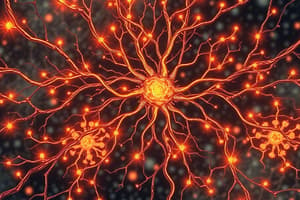Podcast
Questions and Answers
What is the primary function of voltage-gated ion channels in neurons?
What is the primary function of voltage-gated ion channels in neurons?
- To increase the magnitude of the resting membrane potential
- To regulate the release of neurotransmitters
- To provide structural support to the axon
- To generate an action potential by altering the membrane potential (correct)
What is the purpose of the myelin sheath in axons?
What is the purpose of the myelin sheath in axons?
- To regulate the release of neurotransmitters
- To generate action potentials
- To increase the diameter of the axon
- To provide insulation and facilitate faster conduction of action potentials (correct)
What happens to the membrane potential during the peak of an action potential?
What happens to the membrane potential during the peak of an action potential?
- It becomes hyperpolarized
- It reaches the threshold potential
- It remains at the resting potential
- It becomes depolarized (correct)
What is the function of nodes of Ranvier in axons?
What is the function of nodes of Ranvier in axons?
What is the role of neurotransmitters in neurons?
What is the role of neurotransmitters in neurons?
What happens to K+ ions during the repolarization phase of an action potential?
What happens to K+ ions during the repolarization phase of an action potential?
What is the term for the process of an action potential jumping from node to node?
What is the term for the process of an action potential jumping from node to node?
What is the threshold potential in neurons?
What is the threshold potential in neurons?
What is the primary function of the axon terminal?
What is the primary function of the axon terminal?
What is the term for increasing the polarity of a biological membrane?
What is the term for increasing the polarity of a biological membrane?
Flashcards are hidden until you start studying
Study Notes
Neuron Firing and Action Potential
- A neurotransmitter binds to receptors on a neuron's dendrites, opening voltage-gated ion channels, which floods the neuron's interior with positive ions, decreasing the voltage difference between the inside and outside of the neuron.
- The neuron depolarizes to its threshold potential (-55 mV), opening Na+ channels in the axon hillock, starting an action potential.
- Once the sodium channels open, the neuron completely depolarizes to a membrane potential of about +40 mV.
- The action potential travels down the neuron as Na+ channels open.
Hyperpolarization and Return to Resting Potential
- Action potentials are "all-or-nothing" events, where the neuron completely depolarizes once the threshold potential is reached.
- As soon as depolarization is complete, the cell "resets" its membrane voltage back to the resting potential.
- The Na+ channels close, beginning the neuron's refractory period.
- Voltage-gated K+ channels open, allowing K+ to leave the cell, making the membrane potential negative again.
- During the refractory period, the neuron cannot fire.
Key Points and Terms
- Action potentials are formed when a stimulus causes the cell membrane to depolarize past the threshold of excitation, causing all sodium ion channels to open.
- The action potential travels down the axon as the membrane of the axon depolarizes and repolarizes.
- Myelin insulates the axon to prevent leakage of the current as it travels down the axon.
- Nodes of Ranvier are gaps in the myelin along the axons, containing sodium and potassium ion channels, allowing the action potential to travel quickly down the axon by jumping from one node to the next.
- Terms:
- Action Potential: An electric nerve impulse that travels through a neuron when it is set off by a "trigger", changing the neuron's charge from negative to positive.
- Resting State/Resting Potential: A negative electrical charge of about -70 millivolts within a neuron.
- All-or-none law: The rule that neurons are either on or off.
- Depolarization: A decrease in the difference in voltage between the inside and outside of the neuron.
- Hyperpolarize: To increase the polarity of something, especially the polarity across a biological membrane.
- Saltatory Conduction: The process of regenerating the action potential at each node of Ranvier.
- Nodes of Ranvier: A small constriction in the myelin sheath of axons.
Formation of an Action Potential
- The formation of an action potential can be divided into five steps:
- A stimulus from a sensory cell or another neuron causes the target cell to depolarize toward the threshold potential.
- If the threshold of excitation is reached, all Na+ channels open and the membrane depolarize.
- At the peak action potential, K+ channels open and K+ begins to leave the cell, while Na+ channels close.
- The membrane becomes hyperpolarized as K+ ions continue to leave the cell.
- The cell "resets" its membrane voltage back to the resting potential.
Studying That Suits You
Use AI to generate personalized quizzes and flashcards to suit your learning preferences.




